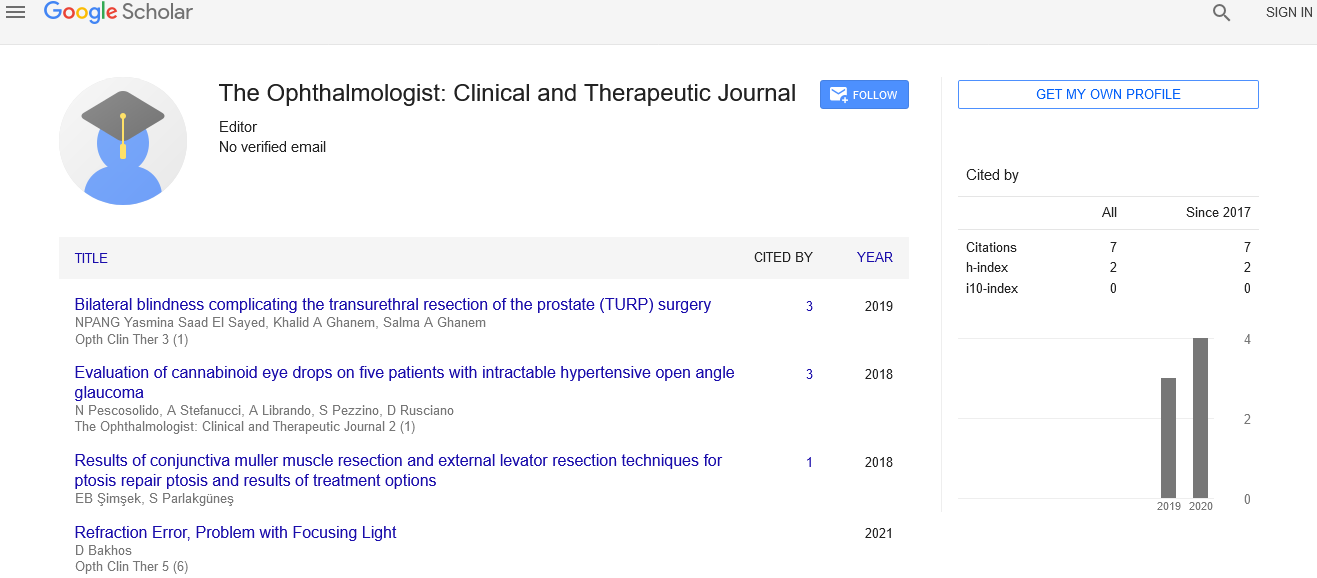New techniques in ocular pathology
Received: 14-Dec-2021 Accepted Date: Dec 28, 2021; Published: 04-Jan-2022
Citation: Garcia JR . New techniques in ocular pathology. Opth Clin Ther. 2021;5(6):4
This open-access article is distributed under the terms of the Creative Commons Attribution Non-Commercial License (CC BY-NC) (http://creativecommons.org/licenses/by-nc/4.0/), which permits reuse, distribution and reproduction of the article, provided that the original work is properly cited and the reuse is restricted to noncommercial purposes. For commercial reuse, contact reprints@pulsus.com
Discussion
Ophthalmic pathology is the subspecialty of surgical pathology and also a subspecialty of ophthalmology which deals with the diagnosis and characterization of neoplastic and non-neoplastic diseases of the eyes. Ophthalmic pathologists typically work closely with ophthalmologists. Moreover, ophthalmic disease in patients with CKD tends to manifest with larger severity compared to those with normal kidney function. Ophthalmic pathology specimens are rarely encountered by general pathologists, once it happens there tends to be a general sense of anxiety encompassing them. Ophthalmic pathologists study tissues excised by Ophthalmologists to produce an explicit diagnosis of the disease. The pathologic tissue is examined macroscopically (gross examination) and by light microscopy. Different techniques, like assay, molecular testing, and microscopy also are generally utilized. The identification of the disease plays a crucial part in patient care. Ophthalmic pathologists are ready to give the active medical specialist with a tissue diagnosis and with data regarding the cause, pathologic process and prognosis of ocular diseases. Ophthalmic pathologists are a heterogeneous group of sub-specialists who have dedicated all part of their practice to the pathological analysis of tissues from the eye and ocular adnexa (conjunctiva, eyelid, lacrimal system, and orbit). There is no established coaching pathway for ophthalmic pathology and no board certification in ophthalmic pathology. The history of the ophthalmic pathology goes back to the spring of 1945 within the United States Conventional histopathology is rapidly shifting toward digitalization. The ophthalmic diagnostician plays a very necessary role as teacher for residents in medical specialty programs and, in some cases, pathology programs. The Ophthalmology Residency Review Committee and the American Board of Ophthalmology are committed for teaching residents ophthalmic pathology and have created study during this field a necessary demand for completion of residency and board certification in medical specialty. Pathology is that key which has applicability to each organ system and tissue within the body. Thanks to the broad spectrum of conditions pathologists see, it is common to seek out sub-specialization inside this sector. Sub-specialization tends to be notably common in educational and tertiary referral centers and provides a chance for additional in-depth study and data of a selected organ system or tissue. Ophthalmic pathologists are academic medical centres because of their comprehensive data regarding diseases of the attention. By teaching ophthalmologists and trainees in medical specialty (residents and medical students), they contribute to the upkeep of top quality eye care. Ophthalmic pathology may be a branch of cellular pathology (including histopathology and cytopathology), with abundant of its methodology primarily based around light microscopic examination of glass slides are done which are mounted sections of tissue or fluid preparations derived from the patient samples. These preparations are examined morphologically following use of staining ways as well as histochemistry and assay to focus on salient options of the specimen and aid in diagnosis. In some cases, ancillary ways like molecular analysis or electron microscopy is also required. Ophthalmic pathology conjointly referred to as eye or ocular pathology may be an extremely specialized branch of the medical laboratory specialty. Clinical ophthalmic pathology involves gross and microscopic examination and identification of eyes and ocular adnexal part tissues that are removed surgically.
Conclusion
Ophthalmic pathology and excretory organ diseases are related to each other. Patients with CKD encounter with well-known ophthalmic diseases like retinopathy at a rate that exceeds the final population, notably those with diabetic renal disorder. Enhancements in digital technology have led to the creation of glass slide scanners that are ready to turn out whole slide pictures (also known as digital or virtual slides) with high resolution capture of slide details.





